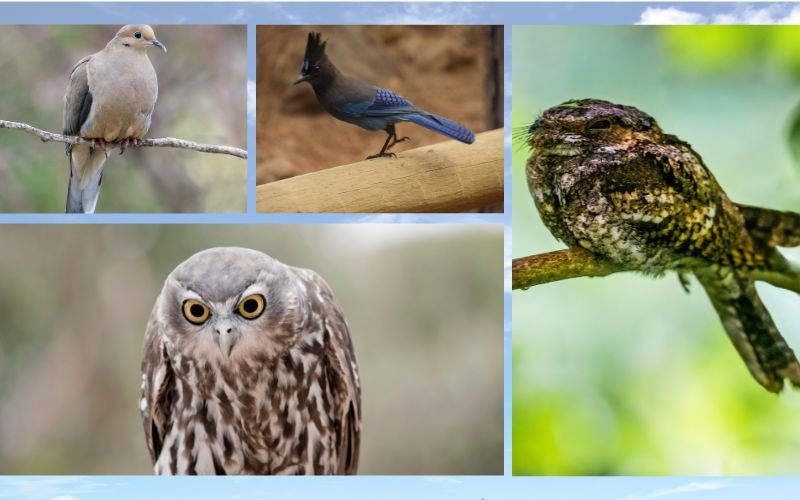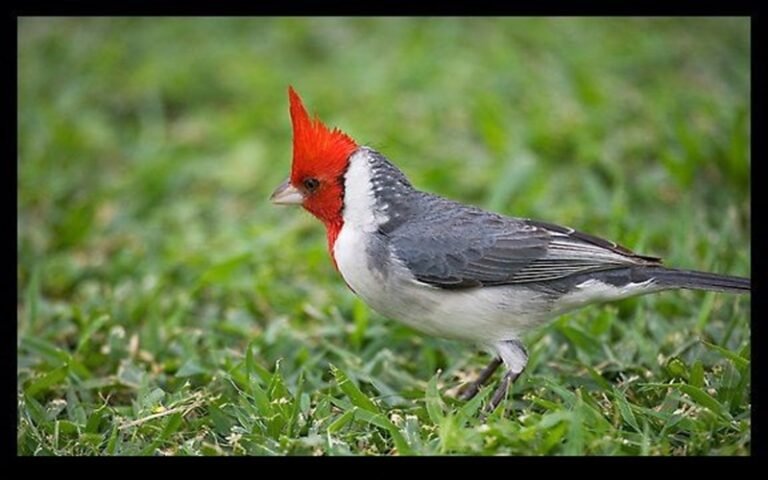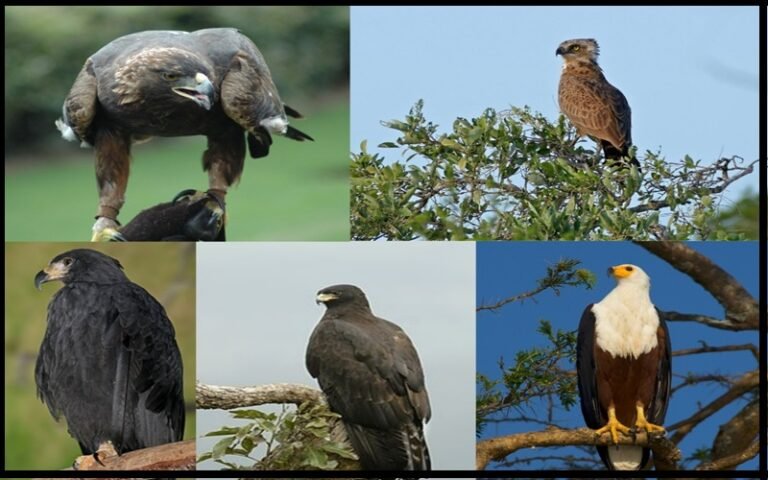10 Bird That Sounds Like an Owl But Isn’t
Owls are distinctively known for their hooting calls at night. However, have you ever wondered whether the hooting calls or sounds you are listening to are actually Owls hooting or not?
In this article, I will talk about 10 birds that sound like owls, but they are not Owls. I’ll also try to provide their other additional aspects, like their scientific names, size, native place, lifespans, wingspan, and diets. I’ll mostly focus on their vocalization components, which are similar to Owls’ hooting and sometimes misguide you.
So, let’s not wait anymore and explore mysterious night-hooting sounds.
10 Bird That Sounds Like an Owl But Isn’t
Owls are known for their nocturnal behavior at night and distinctive voice variation. However, it is important to verify that every hooting sound you hear might not always be owl hooting.
Some birds sound exactly like Owls or mimic their sounds with a certain perfection that might misguide you sometimes.
In this part, I’m going to elaborate on 10 species of avian that sound like owls but are not. In addition, I’ll provide the necessary information, such as their scientific names, size, native places, lifespans, wingspan, diets, and vocalization.
1. Mourning Dove

- Scientific name: Zenaida macroura
- Lifespan: 2-4 years
- Wingspan: 37 to 45 cm
- Native to: North America
- Size: 31 cm
- Food or Diet: 99% seeds, corn, sunflowers, grass, sesame, buckwheat, weed, pine nuts, etc.
Mourning Dove birds belong to the dove family and are recognized as American mourning or rain doves. Sometimes also as turtle doves.
These doves are widely visible in the North American region, including Mexico, the United States, Canada, and Bermuda. They can be found in wide open places, urban areas, grasslands, woodlands, and farms.
However, they avoid swamps and thick forest areas for their habitats. Although these birds’ voices resemble the Owl’s voice so much, their sounds have different high pitches with different syllables.
However, you might mistake their morning hoots with owl hoots. They make these hoo-hoo-hoo or cooOoo-wooo-woo sounds when they try to hunt prey or food.
Sometimes, they also make these hooting sounds to attract mates during breeding seasons with puffed-out breasts and booking heads.
Even if they face any threats they use those vocalization sounds to make an alarm call or signal.
2. Steller’s Jay

- Scientific name:Cyanocitta stelleri
- Lifespan: 16.1 maximum longevity
- Wingspan: 44 cm
- Native to: western North America
- Size: 12 to 13 inches
- Food or Diet: seeds, nuts, reptiles, snakes, lizards, etc.
Steller’s Jays are blue birds with brown heads and beautiful head crests. They are widely spotted in North America, including the Eastern foothills, rocky mountains, and southern Alaska.
Although their favorite place is coniferous trees, they can still be found in other forests, residential areas, and agricultural fields. However, they rarely spot high trees or tree lines.
These Steller’s Jay birds have numerous vocalizations with different sounds and can also mimic the sounds. Their most common sound is shack-sheck-sheck-sheck to shriek, shriek, and harsh calls.
Sometimes, people can’t differentiate these calls from owl sounds. They even make soft hoodie handle sounds. Females also make high-pitched sounds like gleep gleep. Steller’s jaybirds make these sounds both morning and night.
They habitually mimic the owl sounds of espresso at night times. One possible reason is that owls hunt these Steller’s jay birds as prey.
That is why these birds make these sounds to define their territory and traits. They can hear them before and locate their situation to avoid Owls.
3. European Night Jar

- Scientific name: Caprimulgus europaeus
- Lifespan: 4 years
- Wingspan: 20 to 23 inches
- Native to: Europe, Asia, Mongolia, northwestern China
- Size: 9.6 to 11 inches
- Food or Diet: insects, moths, beetles, caterpillars, dragonflies, cockroaches and flies
European nightjar, also known as common goatsucker, Eurasian nightjar, or just nightjar, is a bird that breeds in Europe, Asia, Mongolia, Africa, Iraq, Iran, and the Himalayas.
Later, they migrate to South Africa in winter, along with a few populations in Pakistan, Morocco, and Israel. As these birds are nocturnal, they migrate at night in groups of twenty birds.
During their migration at night, they make sounds or voices that are sometimes confusing, like owls hooting. But in reality, it’s not Owls hooting.
Sometimes, these nightjars can make continuous, high-pitched sounds for 10 minutes from a perch. They also sing a more prominent song during dawn and dark time.
You can also hear these songs from 200 m away. Female nightjars do not sing; however, they sometimes chase away their predators by making wings flapping sounds.
4. Eastern Whip-Poor Will

- Scientific name: Antrostomus vociferus
- Lifespan: up to 15 years
- Wingspan: 45 to 50 cm
- Native to: North America
- Size: 22 to 27 cm
- Food or Diet: Moths, grasshoppers, beetles and other flying insects
Eastern whip-poor-will birds are medium-sized birds belonging to the nightjar family in North America. Including North America, where the breeding range covers Canada and the United States.
Later, they migrate to the southeastern United States, Mexico, and Central America during winter. You can also spot their habitats in wooded areas of mixed wooded places and deciduous forests.
These whip-poor birds also make thrilling, high-pitched sounds, sometimes confusing people who try to distinguish between Owls’ hooting and their hooting calls.
As nocturnal birds like Owls, they also make sounds at night. Their calls sometimes get mixed with other Owls’ hooting sounds, creating an illusion.
However, you can still differentiate them by their sounds with little concentration. These birds make more high-pitched warbly sounds than Owls, which sustain for two seconds.
On the other side, Owls make continuous sounds like the bursts of several shorts.
5. Tawny Frogmouth

- Scientific name: Podargus strigoides
- Lifespan: 14 years in the wild; 30 years in captivity
- Wingspan: 65 to 98 cm
- Native to: Australia
- Size: 13 to 21 inches
- Food or Diet: insects, spiders, worms, slugs, snails, bugs, beetles, wasps, ants, small mammals, reptiles, frogs, etc.
Tawny frogmouth birds are the subspecies of frogmouth birds, which are local birds of the Australian mainland, including Tasmania’s northern and Eastern parts of the state.
However, they enjoy forest habitats, including woodlands, scrub, heathlands, vegetation, and savannah areas. You will rarely see them in rainforests and treeless desert areas.
You can also find their nests in parks and gardens with trees. Sometimes, you can differentiate these birds from owls because of their big heads. They almost look like owls, but most interestingly, they are not owls or related to any owl subspecies.
You can also mistake their nocturnal night sounds with owl bird sounds. They make low-frequency sounds about eight times every 5 seconds.
These birds make these hooting sounds to call their mating partners and to ensure their territory range. Sometimes, they also make those sounds when they are hurt or attacked by other prey birds.
Even so, these birds make low pitched hooting sounds, you can still hear their sounds from miles away.
6. Common Nighthawk

- Scientific name: Chordeiles minor
- Lifespan: 4 to 5 years
- Wingspan: 51 to 61 cm
- Native to: North America
- Size: 22 to 25 cm
- Food or Diet: insects, flies, ants, bees, wasps, butterflies, moths, etc.
Common nighthawk birds are medium-sized nocturnal birds related to the nightjar family. They are mostly local in North American countries.
These birds and their subspecies are highly identified by the presence of their vocalizations. You can hardly spot these birds during the daytime because of their gray, brown, and black coloration.
These birds make nasal sounds of peent or beer during their flight position. They make their high-pitched vocals 30 to 45 minutes after sunset.
They make these vocal sounds during their courtship days to attract or call their mates. As they are nocturnal birds, they are mostly active at night. Sometimes, their sounds get mixed with owls’ hooting sounds.
However, they produce more high-pitched sounds than Owls, which you can differentiate with a focused mind.
7. Wilson’s Snipe

- Scientific name: Gallinago delicata
- Lifespan: 6 years
- Wingspan: 39 to 45 cm
- Native to: North America, South America
- Size: 23 to 28 cm
- Food or Diet: insects, worms, invertebrates, crustaceans, mollusks, etc.
Wilson’s snipes are a subspecies of the common snipe, which belongs to the stocky shorebird category. During the winter season, these birds are mostly native to North and South America. Inside this region, they breed in Canada, the United States, the Peninsula, and Russia.
However, you can spot them as yearly residents on the Pacific coasts of the United States. Their preferred habitats are marshes, bogs, tundra, and wet meadow areas.
Their vocals are also merged with those of other owls, such as the screech owl. They make high-pitched chirping and winnowing sounds, which are similar to those of a Boreal owl.
They also produce these winnowing sounds when the male birds fly in circles during their courtship. Later they do shallow dives by producing distinctive sounds.
8. Chuck- Will’s Widow

- Scientific name: Antrostomus carolinensis
- Lifespan: up to 14 years
- Wingspan: 58 to 66 cm
- Native to: Southeastern United States
- Size: 28 to 33 cm
- Food or Diet: insects, moths, beetles, ants, bats, small birds, etc.
Chuck-Will’s widow birds are another subspecies of the nightjar family of Caprimulgidae. This subspecies is mostly familiar in the Southeastern United States along with Long Island, New York, Ontario, Canada, and Cape Cod.
Later, they migrate to the West Indies, Central America, and Northwestern South America. They are also nocturnal birds and remain active at night.
Their mating calls or sounds are often mistaken for Owls hooting. However, these species maintain some sequence and distinctive rhythm when they produce sounds.
These distinctive sounds might confuse you more. On numerous occasions, they produce repetitive sounds you might hear at night.
These sounds consist of a series of sounds vibrating the middle sounds or notes with two shorter notes.
9. Rock Pigeon

- Scientific name: Columba livia
- Lifespan: 3 to 5 years
- Wingspan: 24 to 28 cm
- Native to: Europe, North America, southeastern Asia
- Size: 29 to 37 cm
- Food or Diet: plants, fruits, and grains
Rock Pigeons, also known as rock doves or common pigeons, are highly distributed in Europe, Asia, and North Africa. During their breeding season, they travel to these regions to secure and successfully breed.
You may spot these birds remaining as residents for years in their local or native places. Rock pigeons also make soft, wavering sounds, which might sometimes misguide you with owl calls.
Their calls vary for different reasons, such as nesting calls, mating calls, territory calls, and threatening calls. Occasionally, they produce alarming sounds or calls when they see predators around them.
Their hoo-hoo sounds in the late evening and early morning also reflect Owls hooting.
10. Band Tailed Pigeon

- Scientific name: Patagioenas fasciata
- Lifespan: up to 14 years
- Wingspan: around 66 cm
- Native to: America
- Size: 33 to 40 cm
- Food or Diet: acorns, berries, wild grapes, seeds, buds, young leaves, nuts, flowers, etc.
Band-tailed Pigeons are medium-sized birds widely found in America. Their ranges cover British Columbia, Washington, California, Southern Arizona, Mexico, Central America, and Northern America.
In the autumn season, they migrate to northern California, New Mexico, Utah, and Colorado from outside their permanent residence. Band-tailed pigeons also sound similar to owl birds.
Sometimes, you might be confused by their calls. They make cooing sounds when they are feeding their young. Besides, they also make soft clicking sounds when they fly to roost for the night. During that time, their low hooting sounds seem exactly like Owl’s hooting.
Conclusion
In closing, I’ll suggest that not every sound you encounter at night is Owl hooting. From this article, you can easily find out that there are few avian species or birds that exactly or partially sound like Owl birds.
Their similar sounds personified their nocturnal behavior, mating calls, territory calls, and threatening sounds at night, which are sometimes marginalized with Owl sounds at night but are not exactly owl sounds.







